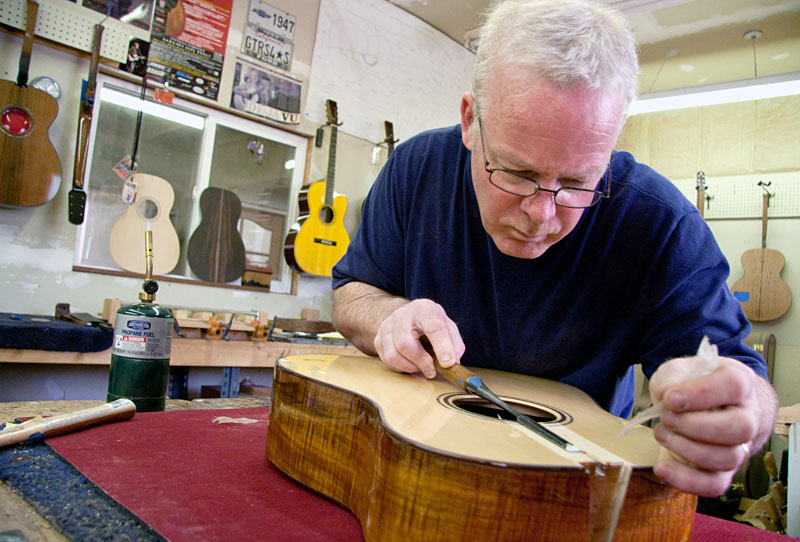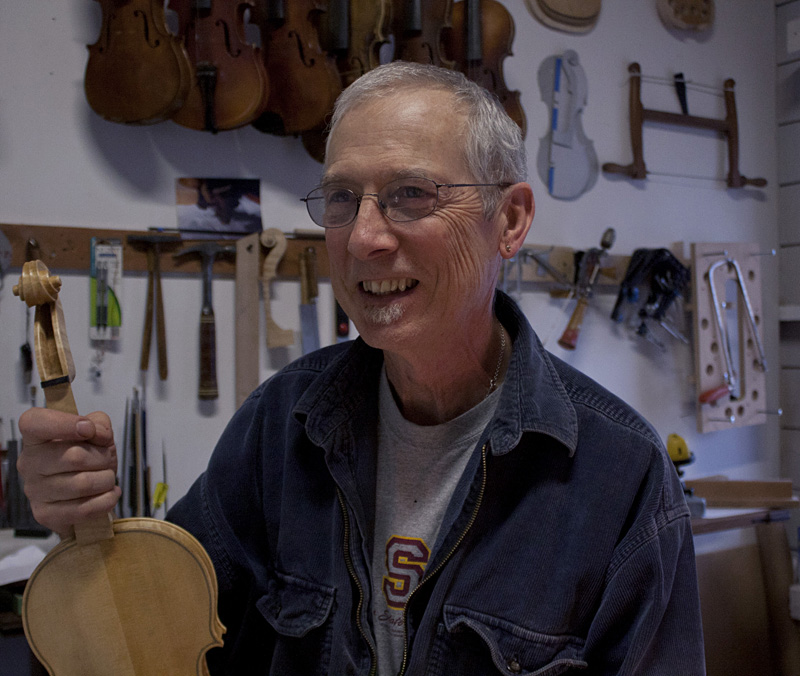Human terms describe a guitar. A head and neck nestle into the fertile curves of a body. Components of its anatomy are carefully chosen and crafted by luthiers like Roy McAlister, giving the guitar a voice.
“It’s a very personal and intimate instrument,” he says. “They pulsate, truly breathe, and human interactions give them personalities and life.”
The voicing begins with the wood, he explains on a recent afternoon in his workshop in the woods outside Gig Harbor, a Pierce County town across Puget Sound from Tacoma. A fine wood dust clings to the corners of photos overlooking a 35-year-old beaten and dented workbench iced with stalactites of glue. Among the photos are shots of McAlister’s famous patrons: David Crosby kisses a McAlister guitar in one, and in another he signs a “Thank You.” One of McAlister’s favorites is a fading, slightly out-of-focus snapshot of his then-baby daughter holding her ears while singer/songwriter Jackson Browne strums the strings of one of McAlister’s early guitars.
McAlister runs his hand over a cardboard-thin slice of a future soundboard, and explains how the wood’s growth and composition affect the sound. He comes across almost as a good-natured sage, but quickly checks himself. “Tone is like wine when you get around a lot of guitar people,” he says. “It gets pretentious fast.”
On the reverse side of the soundboard, fluted braces—tuned to shape the guitar’s tones like the exercised neck muscles of an opera singer—crisscross the diaphragmic wood, keeping the board structurally sound against a tension of 20 to 30 pounds per string. “Every little component,” McAlister says, “brings flavor to the sound.”
For this level of crafstmanship, customers are willing to pay a premium. McAlister Guitars start at $6,200 and can exceed $10,000.
It’s taken more than 20 years for his hands to get the feel of it—to know each wood’s timbres, to feel where a piece flexes or tightens. And, according to his admirers, he knows these things well.
“We like guitars to be beautiful, but what we’re really concerned with [is] that they sound fantastic,” Crosby told Seattle Weekly earlier this year, “and his do.”
Getting to a place where some of the artists he most admired were returning the sentiment was no short journey.
McAlister has been monkeying around with guitars since he was 10, following the lead of a guitar-playing older brother whom he idolized in a house with a dad who was a “hell of a blues player.” He started woodwork when he was 15, sweeping floors and stripping furniture at an antiques repair shop in Los Gatos, Calif., south of the Bay Area. After hours in the shop, he was allowed to dabble at guitar modification.
McAlister later studied under master woodworkers, and eventually opened his own shop designing and crafting projects like high-end mantels or a helical staircase. But, he says, “In my heart, I was a guitar maker and guitar player.”
It surprised him to learn that a group of guitar makers just down the road had been building a reputation since 1976, drawing the attention of well-known musicians like Eric Clapton and Tony Rice. At their Santa Cruz Guitar Company, co-founder Richard Hoover and two collaborators had created a workshop model in which a person apprentices with another worker to learn a small component of guitar production, master it, and move on to build other skills. “Everybody here is a guitar maker,” says Hoover. “It’s not just a job; it’s a team effort.”
McAlister walked into the shop in 1992. He remembers looking around and telling Hoover “We’ve got to work together.” He started by brushing stain on necks, working 10-hour days and spending evenings finishing woodworking jobs at his own shop. He quickly moved into different roles as he learned more about making guitars. “The one part of building guitars that I wasn’t going to be able to achieve on my own at the rate I was going was that voicing. Being able to do it every day—weeks, months, years, being able to measure the results . . . I gained that experience from working there,” he says. “Santa Cruz was my dream job.”
But as time went on, his priorities changed. He got married, and decided there was something more important than spending all day in a workshop. “When my daughter was born, I couldn’t take it,” McAlister says, “and I had to be with her.” It was his children’s birth that led him to strike out on his own. He stayed home to watch his daughter, made his own tools, and began to build guitars on his own. His days as a luthier, he realized, were far from over.
McAlister and Crosby met in the early ’90s, at a turning point in McAlister’s personal and professional life.
“He showed up at my house one day and said, ‘Hi, I helped build your 12-string that Santa Cruz made. My name’s Roy McAlister, and I made a guitar for you that I’d like you to try,’ ” Crosby says. “And I tried it, and it was my favorite guitar that I’d ever played. And still is. So then I became friends with him, and I called some of my friends—Jackson [Browne] and [Graham] Nash, and a couple other people—and said, ‘Hey, you’ve got to hear this guitar.’ “
McAlister tells it slightly differently, saying they met while he was still with Santa Cruz. He was working on a 12-string, and the two hit it off, going out for an occasional pizza to talk over the work.
After McAlister left Santa Cruz, Crosby and his friends bought several guitars, and he was on his way. “I was a real huge Jackson Browne fan,” says McAlister, who relocated his family to the Northwest in 2005. “To get a call from him was an amazing occurrence, but to become close with him and become a friend and build him several guitars . . . It’s extremely fulfilling that these people that you idealize and become your heroes really are cool, and we gained some mutual respect.”
In a musician’s hands, the wood warms, a guitar’s pieces are twisted and pulled, and the instrument takes life.
“As a craftsman, it’s very satisfying that when I complete something, it’s just a beginning,” he says. “For us guys, this is as close to [giving] birth as we’re going to get.”






